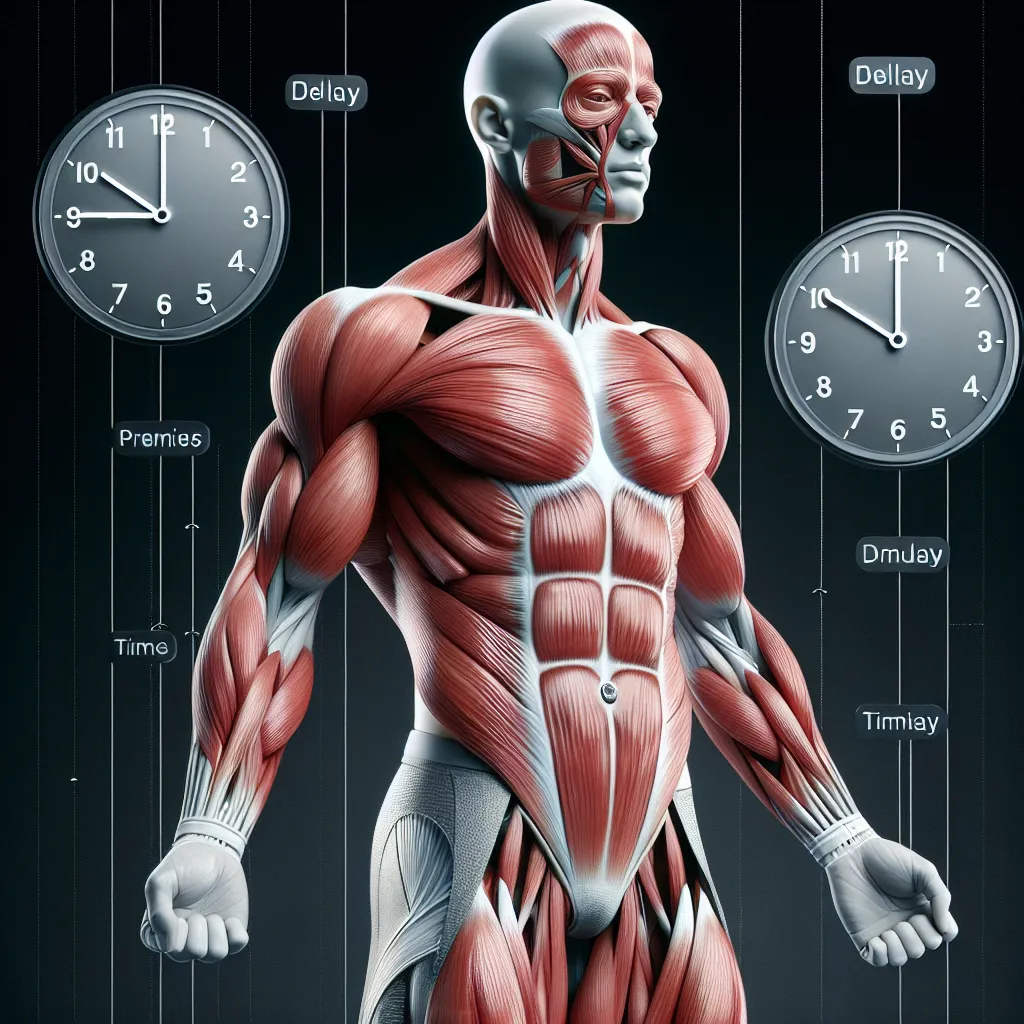Delayed onset muscle soreness (DOMS) is a common phenomenon experienced by many athletes and fitness enthusiasts. As an IELTS candidate, understanding this term and its related vocabulary can be crucial for success in the exam. Let’s dive into the details of DOMS and explore how to effectively use this vocabulary in your IELTS preparation.
Definition and Pronunciation
Delayed onset muscle soreness (DOMS) [noun]
Pronunciation: /dɪˈleɪd ˈɒnset ˈmʌsl ˈsɔːnəs/
Definition: A condition characterized by muscle pain and stiffness that typically occurs 24-48 hours after intense or unfamiliar exercise.

Context and Usage
Examples in Context
-
After an intense weightlifting session, Sarah experienced severe delayed onset muscle soreness in her biceps and chest muscles.
Analysis: This sentence demonstrates the typical scenario where DOMS occurs – following a strenuous workout, particularly one that involves resistance training. -
The marathon runner was familiar with delayed onset muscle soreness and prepared ice baths to alleviate the symptoms.
Analysis: This example shows how experienced athletes anticipate and manage DOMS, highlighting the term’s relevance in sports and fitness contexts. -
Researchers are investigating various treatments for delayed onset muscle soreness to help athletes recover more quickly between training sessions.
Analysis: This sentence illustrates the scientific interest in DOMS, making it relevant for IELTS Academic Writing or Speaking tasks related to sports science or medical research. -
Beginners often mistake delayed onset muscle soreness for an injury, but it’s a normal part of the adaptation process to new or intensified exercise routines.
Analysis: This example provides an explanation of DOMS that could be useful in an IELTS Speaking Part 3 discussion about fitness or health misconceptions. -
To minimize delayed onset muscle soreness, it’s recommended to gradually increase exercise intensity and duration over time.
Analysis: This sentence offers practical advice, which could be incorporated into an IELTS Writing Task 2 essay about health and fitness practices.
Common Contexts
DOMS is frequently discussed in:
- Sports and fitness articles
- Medical journals
- Health and wellness blogs
- Physical therapy and rehabilitation contexts
Vocabulary Analysis
Word Structure
- Delayed: prefix ‘de-‘ (away from) + ‘lay’ (to put off to a later time)
- Onset: ‘on-‘ (forward, toward) + ‘set’ (to place or put in position)
- Muscle: from Latin ‘musculus’ (little mouse, muscle)
- Soreness: root ‘sore’ + suffix ‘-ness’ (state or quality of being)
Synonyms and Antonyms
Synonyms:
- Muscle ache
- Post-exercise soreness
- Exercise-induced muscle damage
Antonyms:
- Muscle comfort
- Exercise ease
- Physical readiness
Memorization Techniques
Mind Mapping
Create a mind map with “DOMS” at the center, branching out to related concepts:
- Causes: Eccentric exercise, New routines, Overexertion
- Symptoms: Pain, Stiffness, Reduced range of motion
- Timeline: 24-48 hours post-exercise, Peak at 48-72 hours, Resolution within 5-7 days
- Management: Rest, Ice, Compression, Elevation (RICE)
Creating a Story
Imagine a character named “Dom” who loves to exercise. One day, Dom tries a new workout and feels great. However, the next day, Dom wakes up feeling sore and stiff. This is Dom’s introduction to DOMS – Delayed Onset Muscle Soreness.
Practice Exercises
-
Write a paragraph describing your experience with DOMS after trying a new sport or exercise routine.
-
Create a dialogue between a fitness trainer and a client explaining DOMS and how to manage it.
-
For IELTS Writing Task 1, describe a graph showing the intensity of DOMS over time after a workout.
-
Practice using DOMS in an IELTS Speaking Part 2 task: Describe a time when you pushed yourself physically and experienced muscle soreness afterward.
-
In an IELTS Writing Task 2 essay, discuss the pros and cons of experiencing DOMS in relation to fitness progress and motivation.
Conclusion
Understanding and effectively using vocabulary related to delayed onset muscle soreness (DOMS) can significantly enhance your performance in the IELTS exam, particularly in tasks related to health, fitness, and sports. By mastering this term and its associated concepts, you’ll be better equipped to discuss physical exercise and its effects on the body, a topic that frequently appears in various sections of the IELTS test.
Remember to practice using this vocabulary in context, whether you’re writing essays, describing graphs, or engaging in speaking tasks. The more you incorporate these terms into your language practice, the more natural and confident you’ll become in using them during the actual exam.
We encourage you to share your experiences with learning and using DOMS-related vocabulary in the comments section below. How has this knowledge improved your IELTS preparation? Do you have any questions about using these terms in specific IELTS tasks? Your insights and queries can help fellow learners and contribute to a richer understanding of this important vocabulary area.